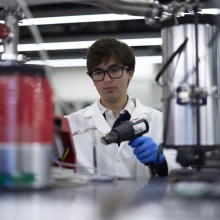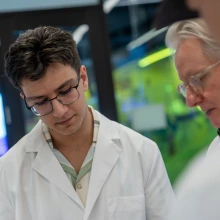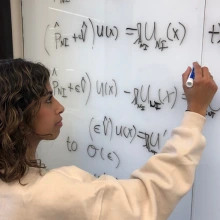NewFoS Research Experience and Mentoring (REM)
The New Frontiers of Sound (NewFoS) Research Experiences and Mentoring (REM) program is a 12-month opportunity funded by the National Science Foundation (NSF) that introduces undergraduate students to research and professional development in the field of Topological Acoustics (TA). Through NewFoS REM, students spend the summer working in a NewFoS research lab, where they are guided by faculty, graduate students, and postdoctoral researchers. After the summer, students continue with mentoring, leadership development, and skill-building activities throughout the academic year. The program is designed to give undergraduates a first, sustained experience in scientific research, help them build meaningful mentoring relationships, and support them in sharing their work through presentations and projects. NewFoS REM prepares students to see themselves as scientists and leaders while exploring possible pathways to graduate school and careers in science, technology, engineering, and mathematics (STEM).
Program Structure
- 12-Month Student Commitment: REM is not just a summer program. Students remain engaged for one year, including full-time summer research and continued participation during the academic year in preparation for conference presentations and continued mentorship.
- Summer Research: Past students were placed full-time in research labs, typically for 8 weeks at either their own institution or a completely new host site.
- Mentoring Ecosystem: Each student is guided by a team of mentors, including faculty, graduate students, and peers.
- Professional Development: Weekly workshops and primers cover leadership, mentoring, communication, and professional development. These professional development programs were designed using the Linking Integrative Narratives to Create STEM Synergy (LINCSS) framework.
- Presentations: Students share their work at the end of the summer through a research poster and oral presentation as well as a personal StoryBoard of their summer experience.
Outcomes So Far
Launched in June 2025, the REM program has already supported 9 undergraduate researchers across partner institutions in its first summer. Students gained hands-on experience in topological acoustics, developed stronger scientific identities, and grew more confident in pursuing STEM research and graduate pathways.
- 9 undergraduate students completed the inaugural program
- 9 digital storyboards created
- 6 research posters presented
Survey and focus group results showed that students’ knowledge of topological acoustics increased significantly, their interest in STEM graduate programs and research-related careers grew, and their sense of belonging in STEM improved. Mentors also reported that students became more independent researchers and more confident in communicating their work.
“I think it helped me be more confident tackling things that I'm not familiar with and building on new skills. I’m more confident going into the next academic year.” – REM Participant
REM Past Projects
Poster Presentations – Summer 2025
- Ture Gustafson (University of Arizona) — Design of Phononic Crystals for SAW Devices
- Khalil Gatto & Anwar Gatto (University of Arizona) — Low-Temperature Fabrication of PCM Thin Films for Acoustic Waveguides
- Yousif Kandelchy (Wayne State University) — Characterization of SAW Devices for Advanced Radio Frequency Technologies
- Arturo Whipple (University of Arizona) & Snehith John (Wayne State University) — Experimental Realization of SSH Lattice
- Kevin Kraseman (University of Arizona) — Design of Surface Acoustic Wave Devices for Advanced Radio Frequency Technologies
- Catherine Campbell (University of Arizona) & Gotibeh Alhady (Wayne State University) — Phononic Crystals with Tunable Properties for Applications in SAW Devices
Image

| Image

| Image

| Image

|
INSIDE THE NewFoS Research Experience
Discover how undergraduate researchers are building the future of science and how you can join them.
Interested in Joining the REM Program?
The NewFoS REM program is more than just a summer research experience — it’s a community. There are several ways to get involved:
- Students: Applications for the next REM cycle are open. Visit the Application page or contact us at gbatchelder@arizona.edu for questions or details.
- Student Council: Any student can join the Student Council as a general member to stay informed about student work and get involved with topological acoustics activities.





